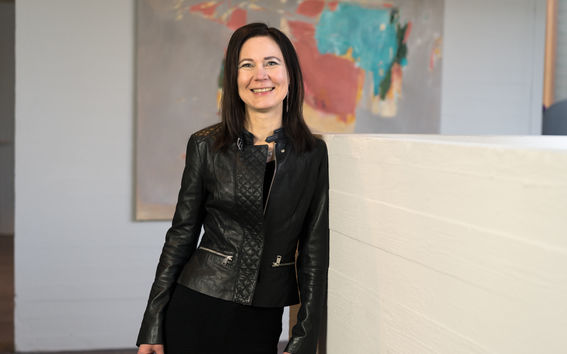A maker of better materials

'I have always been interested in raw materials and their characteristics,' says Professor Tanja Kallio from the School of Chemical Technology.
Ms Kallio and her research group search for materials that could improve the functioning, safety and eco-friendliness of lithium -ion batteries and electrocatalysts.
Batteries are a part of most everyone's daily lives - they are found e.g. in mobile devices. Electrocatalysts, on the other hand, are needed for storage of electricity e.g. when using renewable energy.
From expensive raw materials to an affordable ones
Last year, research groups headed by Professor Tanja Kallio, Professor Kari Laasonen and Professor Esko Kauppinen successfully replaced platinum in electrocatalyst production with coal and iron.
'Coal and iron are both very common and affordable elements, and they are easily accessible. They can also be recycled.
At the moment, noble metals are used as raw materials for electrocatalysts. These are very expensive, rare, as well as geopolitically problematic.
'Noble metals are excavated from areas that the EU does not wish to be reliant on, such as Russia. We are trying to develop materials that will be as effective as noble metals, but are more easily accessible and can be recycled.
According to Ms Kallio, the price of electrocatalysts will affect the more wide-spread use, as e.g. the use of solar power requires the storage of energy. Electric power from the sun captured with electrocatalysts is converted into hydrogen and stored for use during cloudy seasons.
'Batteries help when clouds cover the sky for a couple hours. If the cloudy period lasts a couple weeks, this is when hydrogen storage is needed.'
Materials used in batteries make a difference
Organic solvents, which are classified as harmful substances, are currently used in the manufacture process of batteries. Organic solvents are a safety hazard to those who handle them. Additionally, a large amount of resources and energy go into their handling process.
However, solvents are needed so that the binder used in the manufacture of batteries mixes into an even mass with the electrochemically active substance. A couple of years ago, Ms Kallio and her group discovered how the use of organic solvents could be avoided.
'We found a binder that is soluble in water. We were contacted by quite a few international companies.'
According to Ms Kallio, the materials selected also affect how safe a battery is. Batteries contain a large amount of energy, which means that, if they are used incorrectly, they can overheat and in extreme cases explode.
'We examine the characteristics of materials, as well as research the conditions and duration of time for the safe use of batteries.
Feet firmly on the ground
Ms Kallio describes her research as challenging and fascinating. The characteristics of materials are surprising, and one can never know what they will discover along the way.
Ms Kallio says that she spends a large amount of time in the laboratory, as her work is predominantly experimental. Her research group produces new materials, characterises these and researches their electrochemical characteristics.
'We also build actual batteries and test whether they function in, for example, extremely cold and hot conditions.
Cooperation with the business world is an important part of Tanja Kallio's research, and she holds this in high value. Close contact with industry keeps researchers out of their ivory towers.
'We maintain the social impact of the research, while we are in constant interaction with industry. It is easier to keep realities in mind when we have to consider matters from many different perspectives.'
Read more news

Retail therapy fail? Online shopping linked to stress, says study
Shopping, social media use and gaming are the most likely online activities to correlate with stress, according to a new study
Aalto Inventors innovation training coming for hydrogen, quantum and microelectronics researchers this spring
Connect with industry and academic thought-leaders and gain widely applicable skills in communication, intellectual property, and business.
Start the year with new insights – apply for FITech's spring courses!
Deepen your knowledge with courses from Finnish universities of technology, designed to meet the demands of the working life and help deepen your expertise for free.






